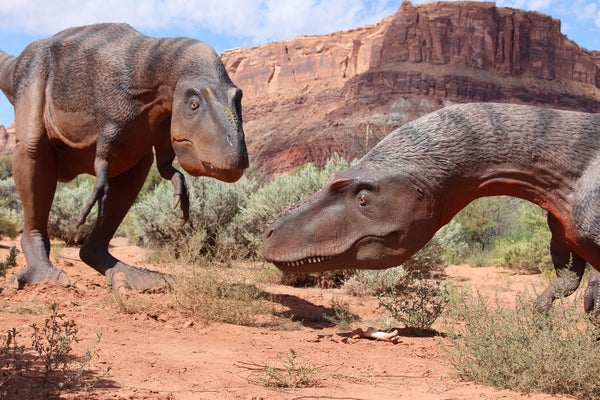This article was published in Scientific American’s former blog network and reflects the views of the author, not necessarily those of Scientific American
We know birds are living dinosaurs. That means, by definition, birds are dinosaur-like. But how bird-like were non-avian dinosaurs?
It’d be a mistake to expect that an Tyrannosaurus would act just like a turkey or an emu. The trick is tracking dinosaurian behavior – looking back and forth between present and past for threads that connect the dinosaurs of old to their modern descendants. Tracks and trace fossils – essentially fossilized behavior – are a great way to do this, with scratches in the Cretaceous soil revealing some of the more bird-like facets of ancient dinosaur behavior.
Early last year paleontologist Martin Lockley and colleagues offered a new interpretation of trace fossils that had puzzled paleontologists for years. At several spots in the Cretaceous strata of Colorado paleontologists had found dozens of scratch marks. They were likely made by large theropod dinosaurs, but what did they mean? The behavior of modern birds seemed to offer an answer – these disturbed divots were display arenas where Cretaceous dinosaurs scraped into the soil just like plovers and other birds do today. Given that trace fossils get their own names, too, the researchers called these fossilized moments Ostendichnus bilobatus.
As often happens when paleontologists discover something unexpected, those scrapes are turning up in other places. Additional scrape sites have been found in Colorado – one spot bearing two different stratigraphic levels of scrapes – and these traces have been found in the Cretaceous rock of Canada, as well. (There are also similar traces from Korea, although the researchers categorize them slightly differently.) And with these new finds, Lockley and colleagues have issued an update on what they think the dinosaurs were doing.
On supporting science journalism
If you're enjoying this article, consider supporting our award-winning journalism by subscribing. By purchasing a subscription you are helping to ensure the future of impactful stories about the discoveries and ideas shaping our world today.
So far, the vast majority of the scrapes have been found in the 97 million year old rock of Colorado’s Naturita Formation. Each set is unique. They were made by dinosaurs of different sizes who put in varying amounts of effort into their displays. Zoom out a little, though, and some curious trends emerge.
At at least one site, Lockley and colleagues report, there are two levels of scratch marks. This suggests that the dinosaurs scraping away at the ground came to this particular spot repeatedly, perhaps over the course of multiple seasons. The Colorado scratch sites are also about three to six kilometers apart. This might mean that individual little displays were going on over a wide geographic area, or, the researchers write, that display arenas might have been huge, involving many dinosaurs spread out over the landscape.
What species of dinosaur made these scrapes, we don’t know. This is one of those cases where the rock that preserved tracks failed to preserve bones or a connection between them. We’re left with what the dinosaurs did rather than their bodies. But imagine something not unlike Albertosaurus, striding along a coastal plain. The dinosaur stops, bellows, and scratches at the ground with its great hind feet, claiming its space and showing off for whoever of its species might be listening. It’s just a small moment of Cretaceous time, but one that has survived tens of millions of years so that we might wonder over it.
Reference:
Lockley, M., Houck, K., Matthews, N., McCrea, R., Xing, L., Tsukui, L., Ramezani, J., Breithaupt, B., Cart, K., Martin, J., Buckley, L., Hadden, G. 2017. New theropod display arena sites in the Cretaceous of North America: clues to distributions in space and time. Cretaceous Research. doi: 10.1016/j.cretres.2017.09.009
